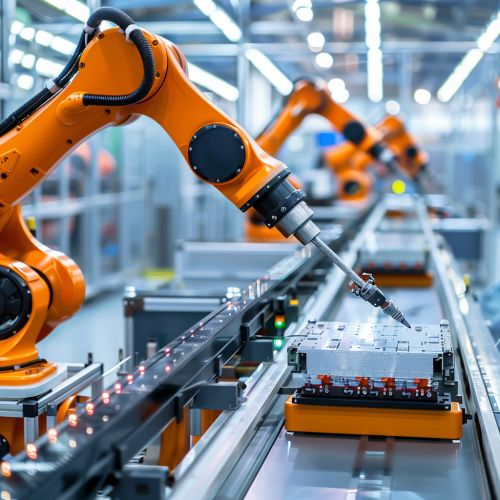Industrial Automation
Overview
Industrial automation is the application of control systems, such as computers or robots, and information technologies for handling different processes and machineries in an industry to replace human beings. It is the second step beyond mechanization in the scope of industrialization.
Evolution
Earlier, the purpose of automation was to increase productivity (since automated systems can work 24 hours a day), and to reduce the cost associated with human operators (i.e., wages & benefits). However, today, the focus of automation has shifted to increasing quality and flexibility in the manufacturing process. In the automobile industry, for example, the installation of pistons into the engine used to be performed manually with an error rate of 1-1.5%. Presently, this task is performed using automated machinery with an error rate of 0.00001%.
Types of Industrial Automation
Industrial automation can be divided into two types:
1. Fixed or Hard Automation: This type of automation is used when the production volume is high, and the products are standardized and the operations are repetitive. The sequence of operation is fixed by the equipment configuration. The operations sequence is determined by the control system. The operations sequence is determined by cams, gears, wiring and the like, and it does not vary from cycle to cycle.
2. Programmable Automation: This type of automation is used when the production volume is low and there is a variety of products. The sequence of operations is changed intermittently and is decided by the coded instructions given to the machines.
Advantages of Industrial Automation
Industrial automation has many advantages, such as:
1. Increased Productivity: Since an automated machine can work 24/7, the productivity increases significantly.
2. High Quality: Automation eliminates the error associated with a human being. Further, unlike human beings, machines do not involve any fatigue, which results in products with uniform quality produced at different times.
3. High Flexibility: Adding a new task in the assembly line requires training with a human operator, however, automation systems can be programmed to do any task.
4. High Information Accuracy: Automated systems accurately collect data at every stage of the manufacturing process. This data can be used for production reports and improve decision making.
5. High Safety: Industrial automation can make the production line safe for the employees by deploying robots to handle hazardous conditions.
Disadvantages of Industrial Automation
Despite its numerous advantages, industrial automation has a few disadvantages too, such as:
1. High Initial Cost: The initial investment associated with the making the switch from a human-operated system to an automated system is high.
2. Unemployment: With the introduction of automation in industries, the human interference has reduced leading to loss of jobs for workers.
3. Dependence on Technology: Over-reliance on technology can be dangerous. If for some reason, the automated system fails, the whole process stops until the problem is fixed.
Applications of Industrial Automation
Industrial automation is used in a variety of industries for different types of applications. Some of the applications are:
1. Manufacturing: Industrial automation is extensively used in manufacturing industries for various processes such as filling, packaging, labeling, palletizing, etc.
2. Automotive: In the automotive industry, automation is used in assembly lines, painting, welding, etc.
3. Pharmaceuticals: In the pharmaceutical industry, automation is used in packaging, labeling, filling, etc.
4. Food and Beverage: In the food and beverage industry, automation is used in packaging, palletizing, filling, sorting, etc.
5. Chemical: In the chemical industry, automation is used in mixing, packaging, palletizing, etc.
Future of Industrial Automation
The future of industrial automation is moving towards reducing the human involvement in unskilled, repetitive tasks and increasing the focus on advanced programming and flexible processes. With the advent of Industry 4.0 and smart manufacturing, we are witnessing a shift towards a more interconnected and flexible system. The use of AI, machine learning and predictive analytics is becoming more prevalent in industrial automation.


